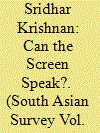| Srl | Item |
| 1 |
ID:
187989


|
|
|
|
|
| Summary/Abstract |
What if a museum is not built out of cement and stone, but codes on a virtual space? In what ways do virtual platforms operationalise the concept of a museum? The paper explores these questions based on the empirical case study of Museum of Material Memory (MMM) and how it operates on Instagram. To this end, the objectives of this paper are twin fold. Firstly, it investigates the characteristics that make MMM a museum as distinct from a social media blog or a website. And secondly, it explores the politics of curation in relation to conventional physical museums in conjunction with issues thrown up by Instagram as a medium of display. The paper argues that MMM’s virtual mode of operation challenges the methods of heritage conservation envisaged by museums by demonstrating how tangible heritage can be museumised through virtual means. In doing so, MMM lays emphasis not only on the object per se, but also on the relationship that the object may have with its setting and the people around it. Such a model of display democratises expertise by obfuscating the difference between producers and consumers of heritage.
|
|
|
|
|
|
|
|
|
|
|
|
|
|
|
|
| 2 |
ID:
165931


|
|
|
|
|
| Summary/Abstract |
This article explores the surprising role of the ancient Buddhist past in the construction of Pakistani national histories in museum exhibits and archaeological guides from 1950 to 1969. Although Pakistan was created as a homeland for Indian Muslims during the 1947 Partition of British India, Pakistani historians struggled to forge a unifying history for the new Muslim nation-state through Islam. In response, Pakistani museum curators co-opted and reframed Buddhist sculptures from before the arrival of Islam to differentiate Pakistan from India and to make sense of Pakistan’s recently drawn borders. They creatively retold the history of ancient Gandhara (first century BCE to fifth century CE), a Buddhist kingdom in northwest Pakistan and Afghanistan, to provide deep historical logic for Pakistan’s existence as a religious homeland in the mid twentieth century and to build global cultural connections to Southeast Asia and to Europe.
|
|
|
|
|
|
|
|
|
|
|
|
|
|
|
|